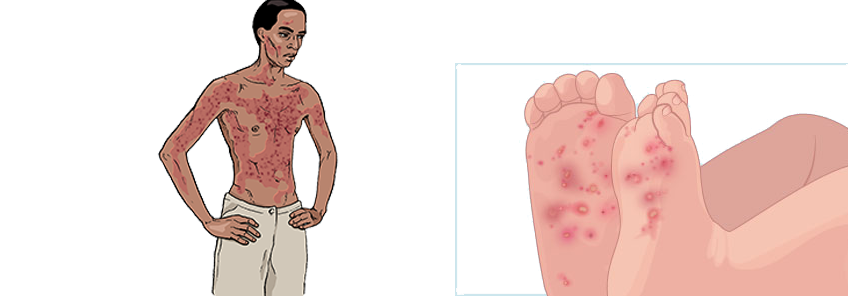Skin Rash

Skin rash is any change in color or texture of the skin. This happens due to wide variety of conditions, some are limited to skin while others affect mucous membrane or internal organs. So skin rash may be mild illness or a very serious condition.
Causes of Rash
- Infections due to bacteria, virus, fungus, parasites
- Allergens
- Medications
- Cosmetics
- Physical agents (light,heat, cold)
- Immune related disorder
- Systemic disease like HIV, syphilis
Some Conditions with Rash
Atopic dermatitis: Also known as eczema, it is chronic condition that causes itching and inflamed skin. It occurs in people who have strong personal or family history of allergy, asthma or hay fever. The rashes are distributed widely on the face, neck, trunks and limbs. Dry skin, overheating and detergents are known to make it worse. General control measures are avoiding irritants, avoid excessive use of soap, and regular use of moisturizers. Local steroid may be required,
Contact dermatitis: This type of dermatitis occurs due to exposure to an allergen or an irritant.
- Irritant contact dermatitis occurs mostly due to occupational or industrial exposure. People with dry skin or with atopic dermatitis have greater chance of developing irritant dermatitis. Skin lesions mostly occur in the hands and forearms. Skin can crack and have sore. Common causes are detergents, solvents, alkalis and cutting oils.
- Allergic contact dermatitis produces itchy rashes with swelling and sometimes blisters. Common agents are jewely (gold, nickel),cosmetics (hair dyes)and plants.
- Most important part of managing allergic or irritant contact dermatitis is to avoid the contact with the allergen or irritant, and use of protective gloves and clothing where avoiding contact is not possible. Mild steroids help in recovery where the condition becomes worse.
Drug Rash: Drug rash can occur because of allergic reaction to the medicine or as a side effect. Any drug can cause rash, most common are antibiotics, steroids, painkillers, drugs used in epilepsy and drugs used to treat tuberculosis. Most drug rash resolve within days to weeks after the withdrawal of the drug. However, drug rash can be severe and life threatening. One should avoid taking such medicine in future.
Heat rash: Also known as miliaria or sweat rash, occurs due to obstruction of sweat duct. It mostly occurs in hot, humid climates, tightly fitting clothing and overdressing. It appears as tiny, clear, red vesicles over the trunk, forehead, hands and legs that produce pricking sensation. Heat rash generally resolves by itself and is not considered a serious condition. Precautions to be taken are avoiding hot, humid places and avoiding wearing synthetic garments and tightly fitting clothes. Cotton clothes are best because these absorb sweat.
Intertrigo: Skin rash caused by skin to skin friction. It usually occurs in warm, moist areas of the body like the groin, beneath the skin folds of the abdomen, under the breasts, armpits and between the toes. Due to repeated friction, the affected skin can crack resulting in pain and bleeding. Those with weak immune system (like diabetes, HIV) are at risk of bacterial and fungal infection. To avoid intertrigo, skin in area of contact should be kept clean and dry. Use of drying powder and wearing loose clothes helps to control moisture and friction in such areas. If infected, antibiotics or antifungals are needed.
Ringworm: It is a fungal infection which appears as itchy, red, scaly, slightly raised and expanding rings on the body. Ringworm can be transmitted by skin to skin contact or by coming into contact with contaminated objects such as clothing or bedding. Characteristic feature of the ringworm infection is that the ring grows outward as the infection spreads and the central area becomes less infected. It can occur in different parts of the body and are named accordingly:
- Tinea corporis (trunk)
- Tinea capitis (scalp)
- Tinea faciei (face)
- Tinea cruris (groin)
- Tinea pedis (feet)
- Tinea manuum (hand) and
- Tinea unguium (nails).
The infected area should be kept dry and synthetic clothing should be avoided. Antifungal creams, lotion, powder and shampoo are used to treat this condition. Ringworm of nails, scalp and complicated infections require oral antifungal drugs.
Shingles (Herpes Zoster): It is caused by reactivation of chickenpox virus (Varicella zoster virus). When a person suffers from chickenpox, the virus remains inactive in the nerves. Due to weak immunity virus reactivates and gives rise to shingles. Symptoms include itching, pain and eruption of small grouped blisters on the specific areas of the body. The blisters break in few days leaving behind crusts. Shingles usually resolves within a few weeks. Painkillers can be used to relieve the pain. Antiviral drugs are used to in severe cases.
Shingles can affect eyes, which is serious condition and requires immediate care.
Sometimes it can lead to long term painful condition called Postherpetic neuralgia.
Shingles can be prevented by vaccine.
This virus can also affect brain and spinal cord.
Bites and stings: Insect bites (bed bugs, mosquito, spider sandfly) and stings (bees) can give rise to skin rashes. Sometimes it leads to serious allergic reactions which can be life threatening.
Psoriasis: It is long term inflammation of the skin characterized by reddish, well demarcated lesions with silvery scales. Risk factors are: genetic, smoking, obesity, bacterial infections, drugs (example -anti malarial). Commonly involved regions include nails, elbows, knees, scalp and lower back.
Psoriasis can affect joints causing arthritis, and eyes . Steroids and ultraviolet light therapy are commonly used to treat this condition.
Rosacea: It is long term skin inflammation characterized by redness and small red bumps. It mostly involves nose, cheeks, forehead and chin. Spicy foods, skin products, alcohol, stress, extreme temperature and sun exposure have been found to be associated with rosacea.
Lichen planus: It usually appears as itchy, purplish, plane topped lesions mostly on the wrists and legs. Other areas which can be affected are face, hands, scalp, trunk, shin and genitals. The exact cause of Lichen planus is unknown. It can last for many months to a couple of years. The symptoms of itching and stinging can be controlled by applying cold compression. Severe conditions may require use of steroids.
Rash is seen in diseases like Rheumatic fever, syphilis, HIV, Lyme disease, Measles, Zika virus infection
Diagnosis and Treatment Options:
The diagnosis of skin rash is done mainly from the history and examination of the skin lesion. Some of tests frequently used to diagnose skin rash are patch test, prick test, blood test, skin biopsy and culture of samples from the rash. Skin rashes are treated with local or systemic treatment depending upon the cause.
When to seek Medical Care/Red flags?
When skin rash is associated with conditions like-
- Breathing difficulty
- Fever
- Headache
- Confusion
- With eye involvement
- Very young or older person
- Person with weak immune system like kidney failure, diabetes,cancer
- Person taking medicine like anti cancer medicine, steroids
- During pregnancy
- After travel to areas with disease outbreak like zika, ebola



Send us your feedback on this article